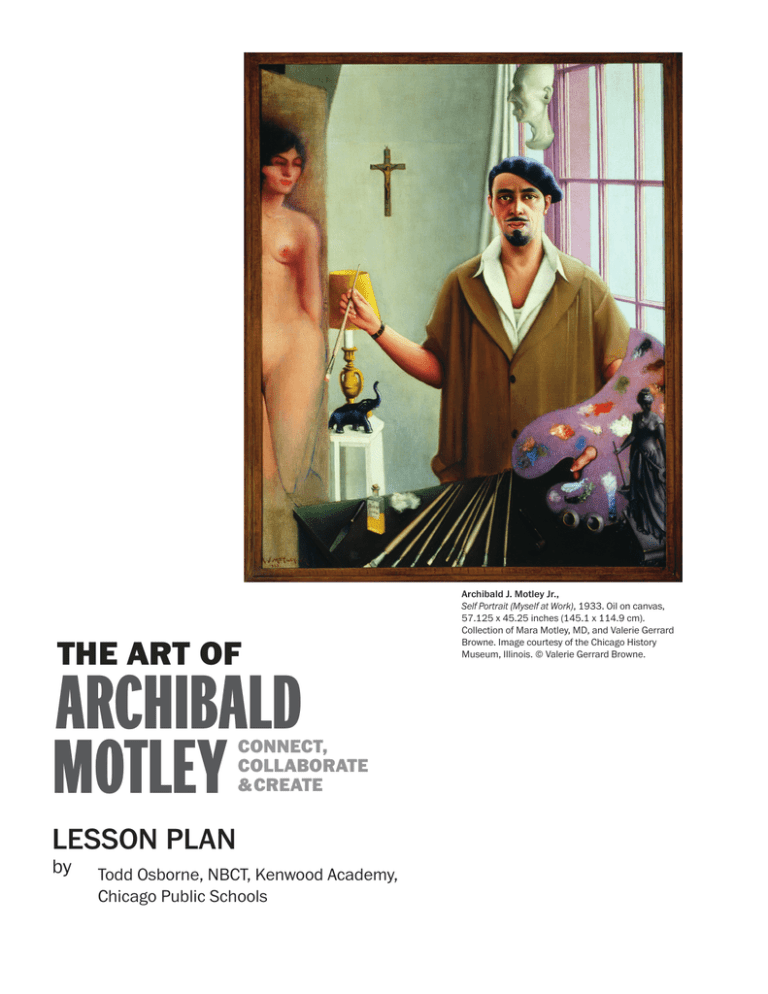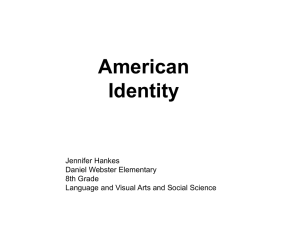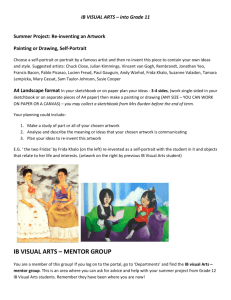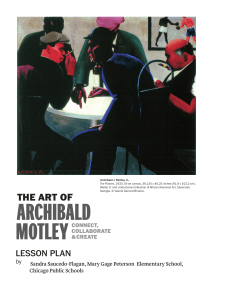Document 14343443
advertisement

THE ART OF ARCHIBALD MOTLEY CONNECT, COLLABORATE & CREATE: LESSON PLAN by Todd Osborne, NBCT, Kenwood Academy, Chicago Public Schools Archibald J. Motley Jr., Self Portrait (Myself at Work), 1933. Oil on canvas, 57.125 x 45.25 inches (145.1 x 114.9 cm). Collection of Mara Motley, MD, and Valerie Gerrard Browne. Image courtesy of the Chicago History Museum, Illinois. © Valerie Gerrard Browne. Summary of lesson plan In this unit for grades 9-12 students will view, discuss and critique artworks by Archibald Motley Jr. and other artists of the Harlem and Chicago Renaissance. After critical analysis of artworks, they will create a personal artwork inspired by Motley’s painting Self-Portrait (Myself at Work), 1933. Students will create a digital artwork in Photoshop representing themselves “at work” doing something they are passionate about, including symbolic visual representations in their backgrounds. Though designed to teach a specific software application, themes of this plan can be adapted to multiple art media. Big Idea • Images carry symbolic meaning and can be used to express ideas through visual (non-textual) communication. • Images are intentionally constructed to convey meaning and evoke some form of reaction in their audience. • Creation (of an artwork, musical score, written story, science experiment, etc.) is a self-critical process, requiring experimentation, exploration and reflection. Enduring Questions • How can I use symbolism to represent aspects of my life and interests? • What emotion(s) do I want to convey with my self-portrait? How can I do this? • How do the environment, dress, and facial expressions of a self-portrait convey meaning? • How can I apply The Elements and Principles of Art to convey an idea or emotion? • (If you are unfamiliar with the Elements and Principles of Art, you can access descriptions here: http://www.getty.edu/education/teachers/building_lessons/formal_analysis.html). Learning Objectives • Students will know who Archibald Motley Jr. was and his place in art history. • Students will know techniques to create the art element of space in an artwork. • Students will understand the significance of Motley’s work and the Harlem and Chicago Renaissance. • Students will understand the use of symbolism works of art. • Students will learn strategies for expressing ideas using visual imagery. • Students will understand how to use tools in Adobe Photoshop to select, adjust and edit images from a variety of sources including: a camera, scanner and the internet. • Students will create a personal artwork, inspired by Motley’s painting, that depicts themselves “at work” doing something they are passionate about. Like Motley, they will incorporate symbolism into their expression to represent their interests. Standard NAEA Anchor Standard #1: Creating Common Core State Standards Objective-Students will . . . CCSS.ELA-Literacy.RL.11-12.7 Students will generate and conAnalyze multiple interpretations ceptualize artistic ideas and work. of a story, drama, or poem (e.g., recorded or live production of a play or recorded novel or poetry), evaluating how each version interprets the source text NAEA Anchor Standard #6 Preforming/Presenting/Producing CCSS.ELA-Literacy.RL.11-12.6 Students will convey meaning Analyze a case in which grasping a through the presentation of artistic point of view requires distinguish- work. ing what is directly stated in a text from what is really meant NAEA Anchor Standard #7 Responding Student will perceive and analyze artistic work. NAEA Anchor Standard #10 Connecting Students will synthesize and relate knowledge and personal experiences to make art. Lesson Plan Activities Length: This is a 7-10 day art project divided in 50-minute class period lessons Materials: to arrange images and compose artwork) with overhead projector. Students will follow along while applying these new skills. • Art critique worksheet • Computer lab with internet writing software and Adobe Photoshop, • Digital projector • Digital cameras (camera phones), • Scanner (optional) and printer (preferred, but optional) Day 1: • Introduction and written art critique (see attached worksheet) of Motley’s Self-Portrait (Myself at Work). Day 2: • Overview of Motley’s artwork and his place in art history, through a slide presentation and class discussion of his work. • Establish purpose: share quotes about work. Slide presentation and discussion of Motley’s artwork; focus on Self-Portrait (Myself at Work), 1933. • Demonstrate techniques for creating the illusion of space in an artwork. • Introduction of Photoshop art-making skills and student art project: A Portrait of Myself (& Symbols) at Work • Teacher will demonstrate creating the illusion of space in an artwork. Teacher will demonstrate new Photoshop skills (selecting and removing backgrounds, adjusting color and value, editing size Days 3-5: • Student studio art-making practice: ideations, image gathering, and using cameras to take portraits • Students arrange the elements of their artworks, and apply the techniques of creating space in an artwork to create their compositions. • Teacher provides guided practice, one-on-one critiques, supportive feedback, etc. Day 10: • Students will select a theme • Self assessment rubric and for their artwork, depicting written reflection on creative themselves “at work” doing process (see attached rubric) something they are passionate about. Themes may include sports, art-making, writing, performing, conducting a Assessments: science experiment, solving an equation on a whiteboard, (D) Diagnostic etc. Students will work with a partner to take an expressive General class survey: What was portrait. the Harlem Renaissance? Who • They will also collect symbolic images with cameras, scanners and from the internet to represent at least 7 aspects of their life, hopes for the future or personal interests. • Student begin to compile images and begin editing their images in Photoshop. • Teacher provides feedback, and guided practice. Days 6-9: was Archibald Motley? Can anyone explain or provide information about either of these? What is symbolism? What is self-portraiture? How does one create the illusion of space in an artwork? (F) Formative – the check for understanding mechanisms used throughout the unit to ensure each student gets the instruction needed to be successful on the summative performance assessment. Examples: reader’s notebooks, post-it jots, small group anecdotal records, discussion, drafts. • Student studio art-making practice: using Adobe Photo- In-progress critiques by teacher shop to select, adjust and edit and peers. Individual critical questioning by teacher regarding images. student’s intention and expres- • Students will use Photosive techniques. Small-group shop to create a self-portrait discussions. collage; they will arrange and edit their various images to create a meaningful artwork of themselves “at work.” They (S) Summative – the “summary of will apply techniques to create student’s achievement in relation to…learning standards.” the illusion of space in an artwork. Works of Art Archibald J. Motley Jr., Self-Portrait (Myself at Work), 1933. Oil on canvas, 57.125 x 45.25 inches (145.1 x 114.9 cm). Collection of Mara Motley, MD, and Valerie Gerrard Browne. Image courtesy of the Chicago History Museum, Illinois. Archibald J. Motley Jr., Self-Portrait, 1920. Oil on canvas, 30.125 x 22.125 inches (76.5 x 56.2 cm). The Art Institute of Chicago, Illinois. Archibald J. Motley Jr., Mending Socks, 1924. Oil on canvas, 43.875 x 40 inches (111.4 x 101.6 cm). Ackland Art Museum, The University of North Carolina at Chapel Hill. Burton Emmett Collection, 58.1.2801. Key information about the Archibald J. Motley, Jr.: Archibald Motley attended the School of the Art Institute of Chicago where he learned the principles of portraiture. He excelled at visualizing his sitter’s interior personalities through the use of exterior signs such as costume, pose, and setting as well as color, light, and line. In 1929, he won a Guggenheim Fellowship that allowed him to study in Paris, where he further honed his skills. Briefly Motley painted murals and taught painting classes at Howard University. Later, he worked as a painter for the Easel and Mural Division of the WPA. He also taught painting and composition lessons at his home studio. Key information about the Motley’s context: Motley’s focus on portraits and inclusion of himself at work, reflects his determination to see African American subjects in fine art. His family supported his ambition to be a professional artist and his efforts reflect the changing attitudes toward race during the Black Chicago Renaissance. According to the Chicago Metro History Education Center “Black Chicago Renaissance” “Chicago experienced a a new surge of African American creativity, activism and scholarship began to flower in the South Side Chicago district then becoming known as “Bronzeville.” This new “Chicago Renaissance” was fueled by two unprecedented social and economic conditions: the “great migration” of Southern blacks to Chicago in search of economic opportunity and perceived security from lynch mob rule and the crisis of the Great Depression that followed.” Key information about Self-Portrait (Myself at Work): In this self-portrait from 1933, Motley depicts himself newly return from Paris (note beret!). He is in a light-filled studio complete with many objects that give further insight to his abilities, interests and beliefs. Motley shows himself in the act of painting a “nude,” a symbol of an established artist throughout art history. As in other portraits, the painter follows the rule of 3rds in his composition. List of resources for teachers and students: • The Art Institute of Chicago, Faces, Places, and Inner Spaces Teaching Manual: Available on-line at: http://www.artic.edu/aic/exhibitions/faces/teacher_motley.html Artwork Resource Packet: Self-Portrait by Archibald J. Motley, Jr. http://www.artic.edu/aic/resourcefinder/resource-type-resourcefinder/45?page=2 • Chicago Metro History Education Center, The Black Chicago Renaissance Resource Guide: Available on-line at: http://www.chicagohistoryfair.org/for-teachers/curriculum/black-chicago-renaissance.html • The J. Paul Getty Museum, “Understanding Formal Analysis,” http://www.getty.edu/education/teachers/building_lessons/formal_analysis.html • Learn NC, The Power of a Portrait: Available on-line at: http://www.learnnc.org/lp/pages/3567 • Nasher Museum of Art, Duke University, Archibald Motley: Jazz Modernist Timeline, artworks and audio guides: http://nasher.duke.edu/motley/#timeline • Powell, Richard J., ed. Archibald Motley: Jazz Age Modernist. Durham: Nasher Museum of Art at Duke U, 2014. Print. Acknowledgments: This lesson plan is the result of a series of professional teacher development workshops initiated by hosted by Columbia College Chicago and Chicago’s Department of Cultural Affairs and Special Events for the exhibition Archibald Motley: Jazz Age Modernist. The exhibition was organized by the Nasher Museum of Art at Duke University. Grant support to the Chicago Department of Cultural Affairs and Special Events provided by the Nasher Museum of Art at Duke University and the Terra Foundation for American Art. Support to the Nasher Museum of Art at Duke University provided by the Terra Foundation for American Art; the National Endowment for the Humanities: Exploring the human endeavor; and the Henry Luce Foundation; and the Wyeth Foundation for American Art. The educational collaboration was facilitated through Columbia’s Department of Education, Art + Design, the Center for Community Arts Partnership and the Dean’s Office for the School of Fine and Performing Arts. Additional support and planning was contributed by Chicago Public Schools, Chicago Public Library, Carter Woodson Branch and the Chicago Metro History Project. Contributing individuals for the Chicago initiative include: Anne Becker, Beverly Cook, Susan Friehl, Michael Flug, Lynne Green, Amy Mooney, Cecil McDonald, Jr., Sadira Muhammad, Lisa Oppenheim, Daniel Schulman, Jennifer Siegenthaler, and Ray Yang. Art critique of Archibald Motley’s Self-Portrait (Myself at Work), 1933 (Note to teacher: This is a guideline for students to create a 2 MEL-Con paragraph art critique, using the claim/evidence model of our literacy TIA at Kenwood Academy HS. In our art department, we have divided critique into 2 main categories: art concepts, and meaning. Worksheet designed by Todd Osborne, NBCT.) Name: Period: 1. Make a claim about the use of art concepts in this painting. (This is your opinion of the artist’s success at applying artistic techniques. You should interpret the artist’s use of the Elements and Principles of Art, and/or his artistic choices including medium, composition, technique, etc.) 2. Write 3 sentences of evidence that support your claim. (These are facts that you see in the artwork. In each sentence, describe and analyze a choice the artist made, and link it back to your claim, i.e. discuss the artist’s use of space, color, emphasis, etc.) A. B. C. 3. Make a claim about what you think the meaning of this artwork is. (This is your opinion of what you think the artist is trying to say through this artwork. What do you think this painting is about? You should interpret the visual images the artist is using.) 4. Write 3 sentences of evidence that support your claim. (These are facts that you see in the artwork. In each sentence, describe and analyze an image or area of the painting you see, and link it back to your claim, i.e. discuss the artist’s use of symbols, subjects, environment, etc.) A. B. C. RUBRIC For Myself (& Symbols) “At Work” Please assess your performance in the following categories as they relate to this project. On a scale of 0 to 20 (0 is the lowest, 20 is the highest) how do you think you did on this project? 1. Craftsmanship and Effort Is your project neatly assembled? Are the backgrounds of each picture neatly removed? Did you make your best effort to create an engaging digital artwork? (0-20):_______ 2. Understanding and Artistic Technique (0-20):_______ Does your project incorporate (at least 7) symbols to represent your interests? Have you clearly demonstrated the use of the Photoshop tools in your artwork? Did you arrange your design elements to create space and a balanced composition? Is your canvas filled? 3. Commitment and Work Habits Were you working consistently throughout this project’s duration? Did you revise/rework areas through this process to make them better? Did you complete your project by the due date? (0-20):_______ 4. Expression and Inventiveness Does your project demonstrate creative solutions to the assignment? Do your “symbols” creatively represent aspects of your life? Did you engage in using Photoshop and the camera as creative tools? (0-20):_______ 5. Reflection and Perception Did your project achieve your artistic goals? Did you incorporate new ideas into your work? Did you incorporate feedback, based on our discussions, into your work? (0-20):_______ TOTAL : /100 Please write (at least) a 1-paragraph reflection of your artwork and your creative process. How did you create the illusion of space? How did you use Photoshop to create your artwork? How do the images and your artistic choices represent aspects of your life and/or interests.... (Please reference the above categories as evidence.)



